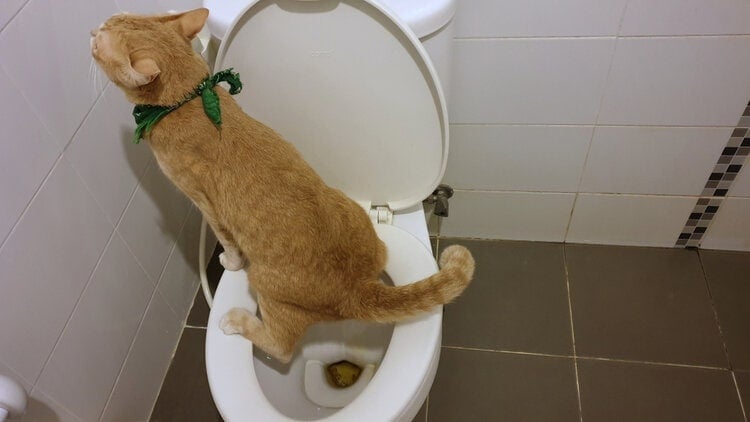This article listed below relating to Don’t flush cat feces down the toilet is absolutely fascinating. Give it a go and draw your own personal findings.

Intro
As feline proprietors, it's necessary to bear in mind how we get rid of our feline buddies' waste. While it may appear convenient to flush pet cat poop down the bathroom, this method can have damaging repercussions for both the atmosphere and human health.
Environmental Impact
Purging pet cat poop introduces dangerous microorganisms and bloodsuckers into the water supply, presenting a considerable risk to water ecological communities. These pollutants can adversely influence aquatic life and concession water quality.
Wellness Risks
In addition to ecological problems, purging feline waste can also present health and wellness threats to humans. Pet cat feces might include Toxoplasma gondii, a parasite that can cause toxoplasmosis-- a potentially severe illness, specifically for expectant women and people with damaged body immune systems.
Alternatives to Flushing
Fortunately, there are much safer and extra accountable methods to throw away pet cat poop. Think about the complying with alternatives:
1. Scoop and Dispose in Trash
One of the most common approach of disposing of cat poop is to scoop it right into a biodegradable bag and throw it in the garbage. Make sure to use a specialized clutter inside story and dispose of the waste without delay.
2. Use Biodegradable Litter
Select naturally degradable feline trash made from materials such as corn or wheat. These trashes are environmentally friendly and can be securely disposed of in the trash.
3. Bury in the Yard
If you have a backyard, take into consideration burying cat waste in a marked area far from veggie yards and water sources. Make certain to dig deep adequate to stop contamination of groundwater.
4. Mount a Pet Waste Disposal System
Buy a pet waste disposal system especially designed for feline waste. These systems utilize enzymes to break down the waste, reducing odor and environmental effect.
Conclusion
Liable family pet ownership extends past providing food and shelter-- it also includes proper waste management. By avoiding flushing pet cat poop down the commode and going with alternate disposal approaches, we can lessen our environmental footprint and protect human health and wellness.
Why Can’t I Flush Cat Poop?
It Spreads a Parasite
Cats are frequently infected with a parasite called toxoplasma gondii. The parasite causes an infection called toxoplasmosis. It is usually harmless to cats. The parasite only uses cat poop as a host for its eggs. Otherwise, the cat’s immune system usually keeps the infection at low enough levels to maintain its own health. But it does not stop the develop of eggs. These eggs are tiny and surprisingly tough. They may survive for a year before they begin to grow. But that’s the problem.
Our wastewater system is not designed to deal with toxoplasmosis eggs. Instead, most eggs will flush from your toilet into sewers and wastewater management plants. After the sewage is treated for many other harmful things in it, it is typically released into local rivers, lakes, or oceans. Here, the toxoplasmosis eggs can find new hosts, including starfish, crabs, otters, and many other wildlife. For many, this is a significant risk to their health. Toxoplasmosis can also end up infecting water sources that are important for agriculture, which means our deer, pigs, and sheep can get infected too.
Is There Risk to Humans?
There can be a risk to human life from flushing cat poop down the toilet. If you do so, the parasites from your cat’s poop can end up in shellfish, game animals, or livestock. If this meat is then served raw or undercooked, the people who eat it can get sick.
In fact, according to the CDC, 40 million people in the United States are infected with toxoplasma gondii. They get it from exposure to infected seafood, or from some kind of cat poop contamination, like drinking from a stream that is contaminated or touching anything that has come into contact with cat poop. That includes just cleaning a cat litter box.
Most people who get infected with these parasites will not develop any symptoms. However, for pregnant women or for those with compromised immune systems, the parasite can cause severe health problems.
How to Handle Cat Poop
The best way to handle cat poop is actually to clean the box more often. The eggs that the parasite sheds will not become active until one to five days after the cat poops. That means that if you clean daily, you’re much less likely to come into direct contact with infectious eggs.
That said, always dispose of cat poop in the garbage and not down the toilet. Wash your hands before and after you clean the litter box, and bring the bag of poop right outside to your garbage bins.
https://trenchlesssolutionsusa.com/why-cant-i-flush-cat-poop/

We are very focused on How to Dispose of Cat Poop and Litter Without Plastic Bags and I am assuming you enjoyed reading my blog entry. Appreciated our piece of writing? Please share it. Let others find it. Thank you for going through it.
This Site